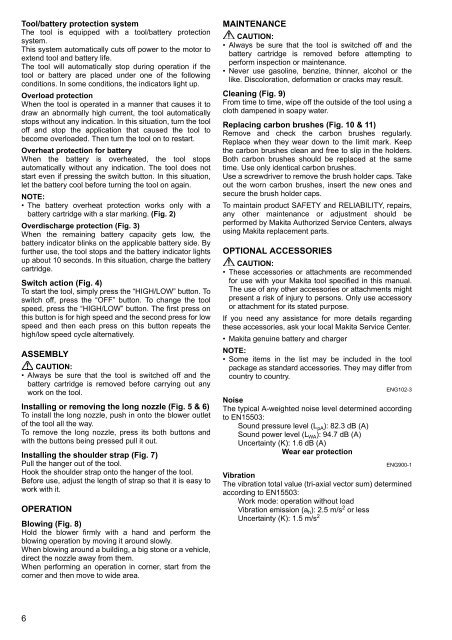Makita Souffleur 36 V => 2 x 18 V Li-Ion - DUB361Z-P - Notice
Makita Souffleur 36 V => 2 x 18 V Li-Ion - DUB361Z-P - Notice
Makita Souffleur 36 V => 2 x 18 V Li-Ion - DUB361Z-P - Notice
Create successful ePaper yourself
Turn your PDF publications into a flip-book with our unique Google optimized e-Paper software.
Tool/battery protection system<br />
The tool is equipped with a tool/battery protection<br />
system.<br />
This system automatically cuts off power to the motor to<br />
extend tool and battery life.<br />
The tool will automatically stop during operation if the<br />
tool or battery are placed under one of the following<br />
conditions. In some conditions, the indicators light up.<br />
Overload protection<br />
When the tool is operated in a manner that causes it to<br />
draw an abnormally high current, the tool automatically<br />
stops without any indication. In this situation, turn the tool<br />
off and stop the application that caused the tool to<br />
become overloaded. Then turn the tool on to restart.<br />
Overheat protection for battery<br />
When the battery is overheated, the tool stops<br />
automatically without any indication. The tool does not<br />
start even if pressing the switch button. In this situation,<br />
let the battery cool before turning the tool on again.<br />
NOTE:<br />
• The battery overheat protection works only with a<br />
battery cartridge with a star marking. (Fig. 2)<br />
Overdischarge protection (Fig. 3)<br />
When the remaining battery capacity gets low, the<br />
battery indicator blinks on the applicable battery side. By<br />
further use, the tool stops and the battery indicator lights<br />
up about 10 seconds. In this situation, charge the battery<br />
cartridge.<br />
Switch action (Fig. 4)<br />
To start the tool, simply press the “HIGH/LOW” button. To<br />
switch off, press the “OFF” button. To change the tool<br />
speed, press the “HIGH/LOW” button. The first press on<br />
this button is for high speed and the second press for low<br />
speed and then each press on this button repeats the<br />
high/low speed cycle alternatively.<br />
ASSEMBLY<br />
CAUTION:<br />
• Always be sure that the tool is switched off and the<br />
battery cartridge is removed before carrying out any<br />
work on the tool.<br />
Installing or removing the long nozzle (Fig. 5 & 6)<br />
To install the long nozzle, push in onto the blower outlet<br />
of the tool all the way.<br />
To remove the long nozzle, press its both buttons and<br />
with the buttons being pressed pull it out.<br />
Installing the shoulder strap (Fig. 7)<br />
Pull the hanger out of the tool.<br />
Hook the shoulder strap onto the hanger of the tool.<br />
Before use, adjust the len<strong>gt</strong>h of strap so that it is easy to<br />
work with it.<br />
OPERATION<br />
Blowing (Fig. 8)<br />
Hold the blower firmly with a hand and perform the<br />
blowing operation by moving it around slowly.<br />
When blowing around a building, a big stone or a vehicle,<br />
direct the nozzle away from them.<br />
When performing an operation in corner, start from the<br />
corner and then move to wide area.<br />
MAINTENANCE<br />
CAUTION:<br />
• Always be sure that the tool is switched off and the<br />
battery cartridge is removed before attempting to<br />
perform inspection or maintenance.<br />
• Never use gasoline, benzine, thinner, alcohol or the<br />
like. Discoloration, deformation or cracks may result.<br />
Cleaning (Fig. 9)<br />
From time to time, wipe off the outside of the tool using a<br />
cloth dampened in soapy water.<br />
Replacing carbon brushes (Fig. 10 & 11)<br />
Remove and check the carbon brushes regularly.<br />
Replace when they wear down to the limit mark. Keep<br />
the carbon brushes clean and free to slip in the holders.<br />
Both carbon brushes should be replaced at the same<br />
time. Use only identical carbon brushes.<br />
Use a screwdriver to remove the brush holder caps. Take<br />
out the worn carbon brushes, insert the new ones and<br />
secure the brush holder caps.<br />
To maintain product SAFETY and RELIABILITY, repairs,<br />
any other maintenance or adjustment should be<br />
performed by <strong>Makita</strong> Authorized Service Centers, always<br />
using <strong>Makita</strong> replacement parts.<br />
OPTIONAL ACCESSORIES<br />
CAUTION:<br />
• These accessories or attachments are recommended<br />
for use with your <strong>Makita</strong> tool specified in this manual.<br />
The use of any other accessories or attachments might<br />
present a risk of injury to persons. Only use accessory<br />
or attachment for its stated purpose.<br />
If you need any assistance for more details regarding<br />
these accessories, ask your local <strong>Makita</strong> Service Center.<br />
• <strong>Makita</strong> genuine battery and charger<br />
NOTE:<br />
• Some items in the list may be included in the tool<br />
package as standard accessories. They may differ from<br />
country to country.<br />
ENG102-3<br />
Noise<br />
The typical A-weighted noise level determined according<br />
to EN15503:<br />
Sound pressure level (L pA ): 82.3 dB (A)<br />
Sound power level (L WA ): 94.7 dB (A)<br />
Uncertainty (K): 1.6 dB (A)<br />
Wear ear protection<br />
ENG900-1<br />
Vibration<br />
The vibration total value (tri-axial vector sum) determined<br />
according to EN15503:<br />
Work mode: operation without load<br />
Vibration emission (a h ): 2.5 m/s 2 or less<br />
Uncertainty (K): 1.5 m/s 2<br />
6
















